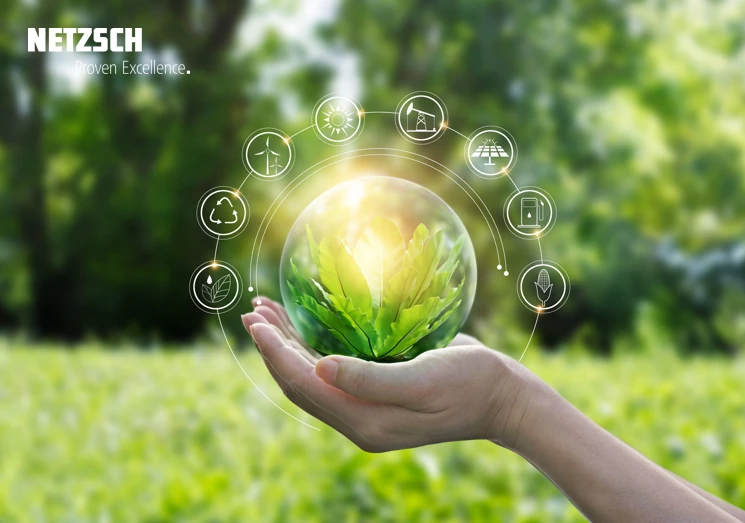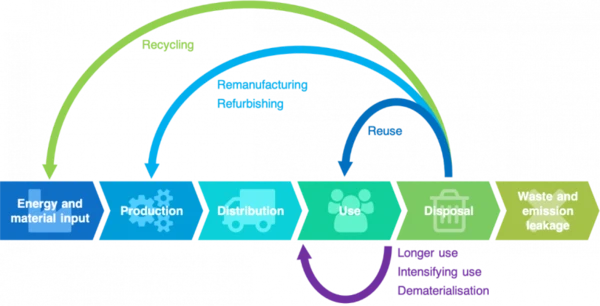
15.03.2021 by Milena Riedl
What is Circular Economy?
Circular economy represents an alternative, more sustainable model to the traditional linear economy. We, at NETZSCH Analyzing & Testing, are regularly test temperature-depended properties of sustainable materials. In the next blog articles, we would like to explain circular economy, the role plastics play in it, and how analytical instruments enable the required material development.
Why do we need a circular economy?
We all know the headlines: Sea levels are rising, glaciers are melting and the great variety of wildlife is disappearing from earth. It has been proven that these detrimental events are caused by global warming, a phenomenon linked to the ever rising emission of greenhouse gases.
Carbon dioxide, methane and nitrous oxide are emitted into our atmosphere when burning fossil fuels, solid waste, trees and other biological materials. They are also released during the production and transport of coal, natural gas and oil as well as through agricultural and industrial activities.
We live in a linear economy
Vast amounts of natural resources are turned into products, which are used for a certain amount of time until they are thrown away as waste.
Continuation of this linear economy will result in a temperature increase of 3°C to 6°C, with potentially catastrophic consequences for life on earth. What can we do? Studies show that a circular economy will allow us to keep global temperature rise well below 2 degrees.
What does circular economy mean?
Circular economy represents an alternative, more sustainable model to the traditional linear economy. In circular economy, resources are used and reused for as long as possible. People extract the highest possible value from them during the period of use.

The three principles of a circular economy
- Design out waste and pollution
Waste and pollution are largely the result of our current approach to design. Changing our mindset, seeing waste as a design flaw, and using new materials and technologies, will lead to a world where waste and pollution are not created in the first place.
- Keep products and materials in use
Circular economy focuses on preserving value in the form of energy, labor, and materials.
It is important to design durable products in a way that allows them to be reused, repaired and remanufactured. The effective use of bio-based materials is another pillar of a circular system.
- Regenerate natural systems
Protecting the environment is no longer sufficient. By returning valuable nutrients to the soil and other ecosystems, it is possible to actively support regeneration. In addition, usage of renewable energy is preferred as opposed to relying on fossil fuels.
The benefits of a circular economy
Adopting a circular economy does not only have beneficial impact on our climate and environment, it enhances our economy and society. Companies benefit from reduced costs due to lower virgin-material requirements, and stronger relationships with customers. Finally, individuals benefit from increased disposable income, improved living conditions, and associated health impacts.
To better understand the benefits of changing how products are designed, used and consumed, it is important to look at two different types of materials.
Material types in our economy
Biological materials can safely re-enter the natural world. After several usage cycles, they biodegrade and act as important nutrients to the environment.
In contrast, technical material such as metals and plastics cannot re-enter the environment. These materials thus have to continuously cycle through our systems in order to capture their value. This means, for instance, maintaining products, reuse and refurbish parts and products as well as recycle materials to be remade into new products.
Plastics in a circular economy
Plastics are increasingly perceived as a major contributor to our environmental problems. In the next blog article, we will discuss the importance of plastics and how they can be recycled and reused. Further, we look at alternative sources to derive plastics from biological materials, making them biodegradable.
Don’t miss our webinar about circular economy
Circular Economy of Plastics: How to make the most of mixed recycling streams
Single-use items make up a huge part of our plastics production today and thus also of our waste stream. On our way from a linear to a circular economy, mechanical recycling has been one of the solutions for many years. However, low prices of virgin materials in comparison to recyclates has hindered that advancement. As current legislation and public attention are pushing in this direction, we want to discuss how thermal analysis methods like Differential Scanning Calorimtry (DSC) and rheology can help identify and successfully process recyclate from mixed recycling streams.
In this webinar we will cover:
- Identification of different materials in available recyclates using NETZSCH products DSC and Identify database search
- Crystallization behavior of a blend out of different packaging materials using DSC
- Miscibility of such blends using rotational rheometry
Sources
https://www.nationalgeographic.com/environment/article/global-warming-overview
https://www.epa.gov/ghgemissions/overview-greenhouse-gases
https://circularity-gap.world/2021
https://www.ellenmacarthurfoundation.org/circular-economy/what-is-the-circular-economy
Image source: https://en.wikipedia.org/wiki/Circular_economy